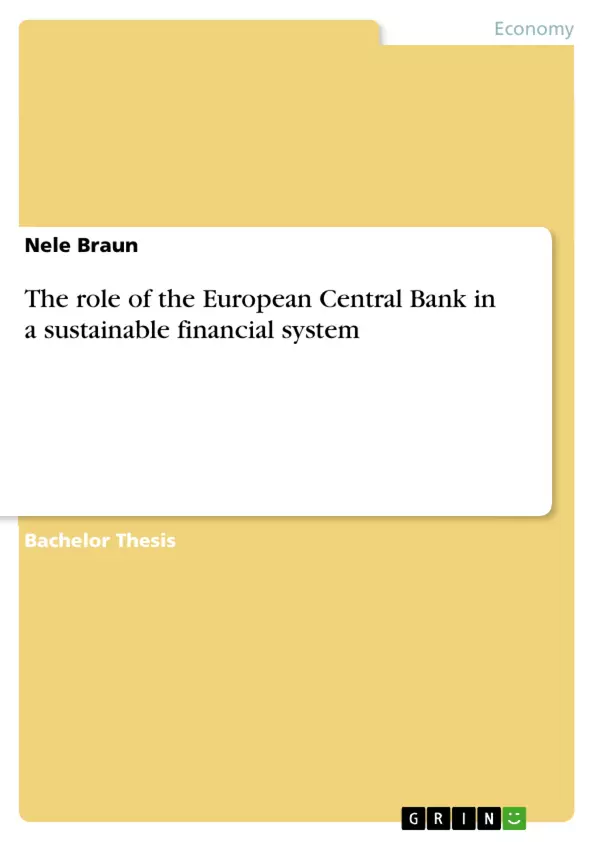To pursue a sustainable financial system, it will be essential to involve the financial sector, as well as its participants and authorities. This thesis discussed the role the European Central Bank could play in a transition towards a sustainable financial system. It outlined how climate-related risks can spread to the financial system and why central banks are concerned of them. While introducing possible instruments for a proactive role of the ECB in different policy areas, the thesis also pointed out the restrictions and risks of the ECB to engage. Next to the possible endangering of their institutional independence, the mandate of the ECB was investigated.
Inhaltsverzeichnis (Table of Contents)
- 1. Introduction.
- 2. A sustainable financial system.
- 2.1 The link between climate change and the financial system.
- 2.2 Climate change and central banks.
- 2.2.1 The role of central banks ...........
- 2.2.2 Climate change and price stability.
- 2.2.3 Climate change and financial stability.
- 2.2.4 Climate change and portfolio management...
- 2.3 The European Green Deal
- 2.3.1 Main aspects of the European Green Deal.
- 3. The possible roles of the ECB in a sustainable financial system
- 3.1 Objectives and mandate of the ECB...
- 3.2 The strategy of the ECB..
- 3.3 The role of soft power of the ECB.
- 3.3.1 Voluntary green finance guidelines and frameworks..
- 3.3.2 Disclosure of the ECB carbon impact.
- 3.4 The role of the ECB in macroprudential regulation ........
- 3.4.1 Climate-related stress tests.
- 3.5 The role of the ECB in microprudential supervision......
- 3.5.1 Disclosure requirements....
- 3.5.2 ESG risk management standards..
- 3.6 The role of the ECB in monetary policy.
- 3.6.1 Green quantitative easing (GQE) ...
- 3.6.2 Green collateral framework...
- 4. Restrictions of the ECB to engage
- 4.1 The role of independence ....
- 4.2 The connection of climate risk and credit risk.
- 4.3 The ECB mandate and conflicting objectives.
- 5. An evaluation of instruments – the PCT approach.........
- 5.1 An assessment of two instruments using the PCT approach.........
Zielsetzung und Themenschwerpunkte (Objectives and Key Themes)
This thesis examines the role of the European Central Bank (ECB) in fostering a sustainable financial system. It delves into the interplay between climate change and the financial system, exploring the implications for central banks, including the ECB's specific mandate and potential contributions.
- The impact of climate change on the financial system.
- The role of central banks in addressing climate change.
- The European Green Deal and its implications for the ECB.
- The potential roles of the ECB in a sustainable financial system.
- Restrictions and challenges the ECB faces in engaging with sustainability.
Zusammenfassung der Kapitel (Chapter Summaries)
- Chapter 1: Introduction - This chapter provides an overview of the context surrounding climate change and its urgency, emphasizing the Paris Agreement and the need for sustainable investment practices.
- Chapter 2: A Sustainable Financial System - This chapter analyzes the connection between climate change and the financial system, discussing the implications for central banks and their roles in promoting sustainability. It also explores the European Green Deal and its main aspects.
- Chapter 3: The Possible Roles of the ECB in a Sustainable Financial System - This chapter examines various roles the ECB could play in a sustainable financial system, including its objectives and mandate, the use of soft power, and potential involvement in macroprudential regulation, microprudential supervision, and monetary policy.
- Chapter 4: Restrictions of the ECB to Engage - This chapter discusses limitations the ECB faces in actively engaging with sustainability, including its role of independence, the connection between climate risk and credit risk, and potential conflicts between its mandate and sustainability objectives.
- Chapter 5: An Evaluation of Instruments – The PCT Approach - This chapter evaluates specific instruments for the ECB's engagement with sustainability using the Proportionality, Competency, and Time (PCT) approach.
Schlüsselwörter (Keywords)
The key focus of this thesis lies in understanding the relationship between climate change and the financial system, with a particular emphasis on the role of the European Central Bank (ECB) in promoting sustainability. It examines key concepts such as the ECB's mandate, price stability, financial stability, the European Green Deal, green finance, climate-related stress tests, ESG risk management, green quantitative easing (GQE), and the Proportionality, Competency, and Time (PCT) approach.
- Quote paper
- Nele Braun (Author), 2020, The role of the European Central Bank in a sustainable financial system, Munich, GRIN Verlag, https://www.grin.com/document/1007537



